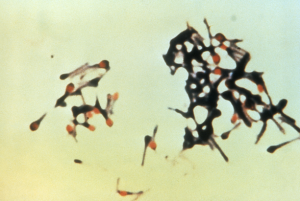Pearl: If forced to ration, the evidence may support targeting tetanus boosters among our ED wounded to patients in the following categories:
A) Any wound and over 50 or never immunized
B) Grossly soiled/crushed wound and >5 years since booster
C) Any wound and >15-20 years since booster
Background: The CDC recommends that following the initial tetanus vaccine series ( DTaP, 4 parts, completed by 18 months) and routine teenage booster (Td) that all US adults receive a routine booster every 10 years or a booster in the context of any potentially tetanus contaminated wound if >5 years have elapsed since the last vaccination or booster (2). This is an inherently conservative recommendation based upon the fact that a very small percentage of patients in some prior studies showed signs of waning immunity after 5-7 years post booster.
Question: What if a tetanus booster was not as abundant as water? What if you were in a refugee camp seeing lots of wounds contaminated with soil as well as garden variety lacerations but but had a limited supply of vaccine? I have selected two studies which might help us suss that out. (3) Hammarlund et al studied 546 healthy volunteers in Oregon to assess the durability of immunity following vaccination. 97% of all subjects (regardless of booster) demonstrated minimal immunity, 99% of those under 60 years. They found a mean half life of immunity to be 14 years, suggesting that 95% of a typical population would remain immune 72 years post vaccination. Wu et all in Taiwan studied another group of healthy clinic patients. Using a higher immunity threshold (effectively definitive rather than minimal), they found that among patients of all ages 5, 10 and 15 years post booster the percentage with definitive immunity was 86, 81 and 50% respectively. However, among patients age 40-50 who reported never receiving a booster, 100% tested above the minimal threshold for immunity, and 50% above the definitive threshold.
Conclusion: There is no definitive conclusion to be reached here. What is notable, however, is that for the typical adult, immunity following childhood vaccination lasts well into adulthood and only really begins to reach questionable levels past your 50s. On the one hand, this should serve as a reminder to treat even mild cuts as an opportunity to re-vaccinate our elderly patients. On the other hand, were tetanus supplies to one day be more restricted, adults under 50, who were previously vaccinated and have low-risk (per CDC) wounds could likely go without a booster. That said, for now, in our plentiful American system, we should stick to the CDC recommendations as above.
Sources:
(1) Clostridium Tetani. By Content Providers(s): CDC – This media comes from the Centers for Disease Control and Prevention’s Public Health Image Library (PHIL), with identification number #6372.Note: Not all PHIL images are public domain; be sure to check copyright status and credit authors and content providers.English | Slovenščina | +/−, Public Domain, https://commons.wikimedia.org/w/index.php?curid=1364651
(2) https://www.cdc.gov/vaccines/pubs/pinkbook/downloads/tetanus.pdf
(3) Hammarlund E1, Thomas A1, Poore EA2, Amanna IJ2, Rynko AE1, Mori M3,4, Chen Z4, Slifka MK1.Durability of Vaccine-Induced Immunity Against Tetanus and Diphtheria Toxins: A Cross-sectional Analysis. Clin Infect Dis. 2016 May 1;62(9):1111-1118.
(4) Wu CJ1, Ko HC, Lee HC, Tsai WC, Li MG, Pao YZ, Lee NY, Chang CM, Shih HI, Ko WC.Decline of tetanus antitoxin level with age in taiwan.J Formos Med Assoc. 2009 May;108(5):395-401.

